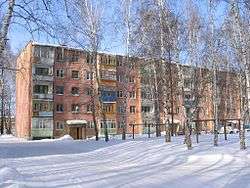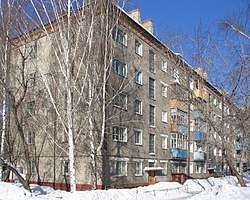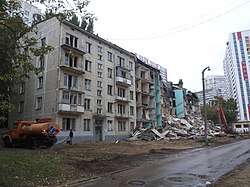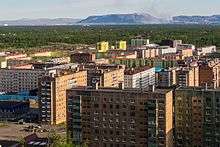Khrushchyovka
Khrushchyovka (Russian: хрущёвка, IPA: [xrʊˈɕːɵfkə]) or Krushcheby (Russian: Хрущобы) is an unofficial name for a type of low-cost, concrete-paneled or brick three- to five-storied apartment building which was developed in the Soviet Union during the early 1960s, during the time its namesake Nikita Khrushchev directed the Soviet government.[1] The apartment buildings also went by the name of khruschoba (Хрущёв + трущоба, Khrushchev-slum). They are sometimes compared to the Japanese danchi,[2] similar (often government-sponsored) housing projects from the same period, which, by some accounts[2] were directly inspired by them.



History
Traditional masonry is labor-intensive; individual projects were slow and not scalable to the needs of overcrowded cities. To ameliorate a severe housing shortage, during 1947–1951 Soviet architects evaluated various technologies attempting to reduce costs and completion time. During January 1951, an architects' convention, supervised by Khrushchev (then the party director of Moscow), declared low-cost, quick technologies the objective of Soviet architects.
Two concrete plants were later established in Moscow (Presnensky, 1953; Khoroshevsky, 1954). By this time, competing experimental designs were tested by real-life construction, and prefabricated concrete panels were considered superior. Other possibilities, like in situ concrete, or encouraging individual low-rise construction, were discarded.
During 1954–1961, engineer Vitaly Lagutenko, chief planner of Moscow since 1956, designed and tested the mass-scale, industrialized construction process, relying on concrete panel plants and a quick assembly schedule. During 1961, Lagutenko's institute released the K-7 design of a prefabricated 5-story building that became typical of the Khrushchyovka. 64,000 units (3,000,000 m2 (32,000,000 sq ft)) of this type were built in Moscow from 1961 to 1968.
In Moscow, space limitations forced a switch to 9 or 12-story buildings; the last 5-story Khrushyovka was completed there during 1971. The rest of the USSR continued building Khrushyovkas until the fall of the Soviet Union; millions of such units are now past their design lifetime.
Design
The Khrushchyovka design represented an early attempt at industrialised and prefabricated building, with elements (or panels) made at concrete plants and trucked to sites as needed. Planners regarded elevators as too costly and as too time-consuming to build, and Soviet health/safety standards specified five stories as the maximum height of a building without an elevator. Thus almost all Khrushchyovkas have five stories.
Khrushchyovkas featured combined bathrooms. They had been introduced with Ivan Zholtovsky's prize-winning Bolshaya Kaluzhskaya building, but Lagutenko continued the space-saving idea, replacing regular-sized bathtubs with 120 cm (4 ft) long "sitting baths". Completed bathroom cubicles, assembled at a Khoroshevsky plant, were trucked to the site; construction crews would lower them in place and connect the piping.
Some theorists even considered combining toilet-bowl functions with the shower's sink, but the idea was discarded. Kitchens were small, usually 6 m2 (65 sq ft). This was also common for many non-élite class Stalinist houses, some of which had dedicated dining rooms.
Typical apartments of the K-7 series have a total area of 30 m2 (323 sq ft) (one-room), 44 m2 (474 sq ft) (two-room) and 60 m2 (646 sq ft) (three-room). Later designs further reduced these meager areas. Rooms of K-7 are "isolated", in the sense that they all connect to a small entrance hall, not to each other. Later designs (П-35, et al.) disposed with this "redundancy": residents had to pass through the living room to reach the bedroom. These apartments were planned for small families, but in reality it was not unusual for three generations of people to live together in two-room apartments. Some apartments had a "luxurious" storage room. In practice it often served as another bedroom, albeit one without windows or ventilation.
Present day

The panel buildings called 'Khrushchyovka' are found in great numbers all over the former Soviet Union. They were originally considered to be temporary housing until the housing shortage could be alleviated by mature Communism, which would not have any shortages. Khrushchev predicted the achievement of Communism in 20 years (by the 1980s). Later, Leonid Brezhnev promised each family an apartment "with a separate room for each person plus one room extra", but many people continue to live in Khrushchyovkas today.
Khrushchyovka standard types are classified into "disposable", with a planned 25-year life (сносимые серии) and "permanent" (несносимые серии). This distinction is important in Moscow and other affluent cities, where disposable Khrushchyovkas are being demolished to make way for new, higher-density construction. The City of Moscow had planned to complete this process by 2015. More than 1,300 out of around 1,700 buildings had been already demolished by 2012.[3] In 2017, Moscow city authorities announced that some 8,000 Khrushchyovkas would be torn down, a move that would cause 1.6 million people to lose their homes. The announcement came after the completion of a smaller demolition project in which 1,700 buildings were torn down.[4]
In some parts of the former Soviet Union and Eastern Bloc countries, efforts to renovate and beautify Khrushchyovkas have been made, such as in Czechia, Slovakia, and Belarus. In many cities, Khrushchyovkas have been transformed from drab, gray buildings to colorful housing blocks through series of renovations. In addition, efforts to improve the quality of the buildings have been made. In Tartu, Estonia, the European Union-funded SmartEnCity turned three Khrushchyovka blocks into energy efficient "smart homes."[5] The renovations are usually heavily subsidized by the state, and in many cases, by the European Union if the country is a member state of the EU. In Russia, Ukraine, and Central Asia these same styles of renovations have not taken place, resulting in further dilapidation of the buildings or, in some cases, the demolition of many Krushchyovkas. In these parts of the former Soviet Union, private renovation has been the norm, explaining the difference in the conditions of the buildings.[6]
Popular references
- 1976 film: The Irony of Fate, though the housing depicted in the film is of the latter, somewhat more advanced and comfortable (if still similarly cookie-cutter) type introduced in the Brezhnev's period
See also
- Urban planning in communist countries
- Plattenbau (Germany)
- Panelház (Hungary)
- Panelák and Sídlisko (Czech Republic and Slovakia)
- Affordable housing
- Public housing
- Subsidized housing
- Housing estate
References
- Russia - Average gas price for Europe could rise to $400 in 2008 - Gazprom - JRL 3-14-08
- Knoroz, Tatiana. "Why Japanese Khrushchyovkas have become unlivable". Strelka magazine.
- http://realty.lenta.ru/news/2012/12/11/xrywevki/%5B%5D
- Morton, Elise. "1.6 million to be rehoused in huge Moscow demolition project". The Calvert Journal. Retrieved 2019-11-21.
- "In the Baltic states, many people are stuck in Khrushchev-era flats". The Economist. 2019-08-15. ISSN 0013-0613. Retrieved 2019-11-21.
- licence, Owen Hatherley, Soviet-era mass housing in Tbilisi Jelger under a CC. "What next for Eastern Europe's mass housing heritage? Owen Hatherley on the past and future of the tower block". The Calvert Journal. Retrieved 2019-11-21.
Sources
- Meuser, Philipp; Zadorin, Dimitrij (2016). Towards a Typology of Soviet Mass Housing: Prefabrication in the USSR 1955 – 1991, DOM publishers, Berlin. ISBN 978-3869224466.
- Meuser, Philipp (2019). Prefabricated Housing. Construction and Design Manual, DOM publishers, Berlin. ISBN 978-3-86922-021-5
External links
| Wikimedia Commons has media related to Khrushchev houses. |
- The Khrushchovkas – The Ukrainian Observer
- Soviet-Era Housing Gets New Lease of Life – The St. Petersburg Times